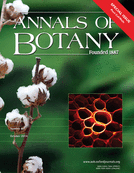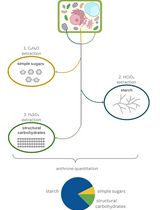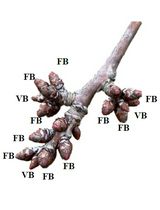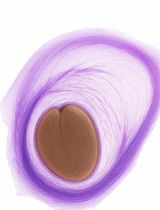- EN - English
- CN - 中文
Cell Wall Biomass Preparation and Fourier Transform Mid-infrared (FTIR) Spectroscopy to Study Cell Wall Composition
细胞壁生物质的制备和傅里叶变换中红外(FTIR)光谱法研究细胞壁组成
发布: 2015年06月05日第5卷第11期 DOI: 10.21769/BioProtoc.1494 浏览次数: 9971
评审: Samik BhattacharyaArsalan DaudiAnonymous reviewer(s)
Abstract
Plant cell wall biomass is an abundant and renewable organic resource. Of the polymers it encloses, cellulose and hemicellulose are regarded as a raw material for the production of fuels and other products (Klemm et al., 2005; Slavov et al., 2013). Nonetheless, current usage of lignocellulosic biomass is still below its full potential due to a series of limiting factors mainly related to the cell wall recalcitrance to saccharification, a severe constraint to maximum biomass usability in downstream processing (Pauly and Keegstra, 2008).
As a strategy to optimise bio-energy and bio-refining applications, an increasing amount of effort is being put into the advancement of our knowledge concerning the cell wall compositional roots of recalcitrance. Fourier transform mid-infrared spectroscopy (FTIR) represents a very useful tool on this enterprise, as it allows for a high-throughput, non-destructive and low unit cost procedure for the examination of cell wall biomass (Allison et al., 2009; Carpita and McCann, 2015). Furthermore, the use of Attenuated Total Reflection (ATR) in conjunction with infrared spectroscopy (IR) enables cell wall biomass samples to be examined in solid state without extensive preparation. Nonetheless, the analysis of purified cell wall preparations instead of the intact plant biomass is highly recommended, as it minimises or even eradicates interference from biomass components which are not part of the cell wall. Further information regarding the fundamentals of FTIR may be found elsewhere (Smith, 2011).
Datasets generated from FTIR spectroscopy can be extensive and complex. In these situations, data-driven modelling techniques are often used as exploratory approaches to identify the most distinctive features of the collected spectra. Here we suggest the use of Principal Component Analysis (PCA), a frequently employed method to transform a large set of variables into a smaller set of new variables (principal components), effectively reducing dataset dimensionality.
When the aim is a complete and detailed biomass characterisation, the FTIR-PCA method here described does not exclude the need for parallel wet gravimetric and analytical procedures. However, it does lead to a rapid identification of the major compositional shifts across large sets of samples; thus contributing to steer research pathways, minimise time-draining analytical procedures and reduce overall research costs.
Background
Materials and Reagents
- Lignocellulosic biomass
Note: Depending on the aims of the researcher, lignocellulosic biomass from different species, organs or tissues may be used, providing it is conveniently prepared as indicated in the Procedure section below. For an example of the application of this protocol, please refer to da Costa et al. (2014). - Deionised H2O
- 70% (v/v) aqueous ethanol (molecular biology grade)
- Chloroform/methanol (1:1 v/v) (molecular biology grade)
- 100% acetone (molecular biology grade)
- Type-I porcine α-amylase (Sigma-Aldrich, catalog number: A6255 ) (saline suspension; 29 mg protein/ml; 1714 units/mg protein)
- 0.1 M sodium acetate buffer (see Recipes)
- 0.1 M ammonium formate buffer (see Recipes)
- 0.001 M sodium azide (see Recipes)
Equipment
- Laboratory safety equipment (gloves, eye protection and safety mask are recommended particularly during sodium azide handling)
- Freezer
- pH meter
- Freeze dryer (Edwards Pirani 501 Super Modulyo, Edwards Ltd.)
- Analytical mill (Ika, A11 basic)
- Sieves (pore sizes: 0.18 and 0.85 mm)
- Plastic centrifuge tubes (50 ml, with screw cap) (Greiner Bio-One GmbH)
- Vortex mixer
- Shaking incubator
- Centrifuge
- Fume hood
- Block heater
- FTIR spectrometer (Equinox 55, Bruker Optik) equipped with a Golden Gate ATR accessory (Specac)
Software
- Bruker OPUS IR spectroscopy software (version 5.0; Bruker Optik)
Procedure
文章信息
版权信息
© 2015 The Authors; exclusive licensee Bio-protocol LLC.
如何引用
da Costa, R. M. F., Allison, G. G. and Bosch, M. (2015). Cell Wall Biomass Preparation and Fourier Transform Mid-infrared (FTIR) Spectroscopy to Study Cell Wall Composition. Bio-protocol 5(11): e1494. DOI: 10.21769/BioProtoc.1494.
分类
植物科学 > 植物生物化学 > 糖类
生物化学 > 糖类 > 多糖
您对这篇实验方法有问题吗?
在此处发布您的问题,我们将邀请本文作者来回答。同时,我们会将您的问题发布到Bio-protocol Exchange,以便寻求社区成员的帮助。
提问指南
+ 问题描述
写下详细的问题描述,包括所有有助于他人回答您问题的信息(例如实验过程、条件和相关图像等)。
Share
Bluesky
X
Copy link












